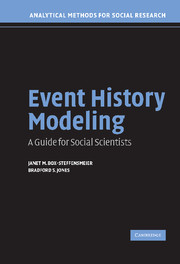Book contents
- Frontmatter
- Contents
- List of Figures
- List of Tables
- Preface
- 1 Event History and Social Science
- 2 The Logic of Event History Analysis
- 3 Parametric Models for Single-Spell Duration Data
- 4 The Cox Proportional Hazards Model
- 5 Models for Discrete Data
- 6 Issues in Model Selection
- 7 Inclusion of Time-Varying Covariates
- 8 Diagnostic Methods for the Event History Model
- 9 Some Modeling Strategies for Unobserved Heterogeneity
- 10 Models for Multiple Events
- 11 The Social Sciences and Event History
- Appendix: Software for Event History Analysis
- References
- Index
6 - Issues in Model Selection
Published online by Cambridge University Press: 05 September 2012
- Frontmatter
- Contents
- List of Figures
- List of Tables
- Preface
- 1 Event History and Social Science
- 2 The Logic of Event History Analysis
- 3 Parametric Models for Single-Spell Duration Data
- 4 The Cox Proportional Hazards Model
- 5 Models for Discrete Data
- 6 Issues in Model Selection
- 7 Inclusion of Time-Varying Covariates
- 8 Diagnostic Methods for the Event History Model
- 9 Some Modeling Strategies for Unobserved Heterogeneity
- 10 Models for Multiple Events
- 11 The Social Sciences and Event History
- Appendix: Software for Event History Analysis
- References
- Index
Summary
A wide variety of models for duration data have been discussed. Each of the approaches has certain advantages and disadvantages. The principal argument we have made is that in most social science settings, the Cox model should generally be preferred over its alternatives, for example the parametric models or some of the discrete models discussed in the last chapter. In this chapter, we revisit some of the models proposed and discuss some of the desirable and undesirable features inherent in the implementation of them. Following this discussion, we consider another class of models that create, in a sense, a “middle ground” between the Cox and parametric alternatives. The basic models discussed in this section are proposed by Royston (2001) and Royston and Parmar (2002).
Advantages and Disadvantages of Modeling Strategies
In this section, we discuss some of the advantages and disadvantages of the parametric models, discrete-time models, and the Cox models. We consider the standard parametric models first.
Parametric Models Revisited
The principal advantage of parametric duration models is the ability of the model to provide parameter estimates while simultaneously producing a relatively simple and easy-to-interpret characterization of the baseline hazard rate. Further, the parametric approach is flexible insofar as one simply needs to specify one of any number of suitable distribution functions. Commonly (and often by default), the Weibull distribution function is the distribution of choice in many applications; but there are numerous other functions that can be applied to duration data (each having concomitant assumptions regarding h0(t)).
- Type
- Chapter
- Information
- Event History ModelingA Guide for Social Scientists, pp. 85 - 94Publisher: Cambridge University PressPrint publication year: 2004

